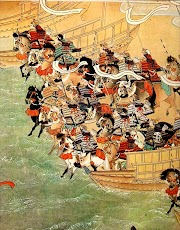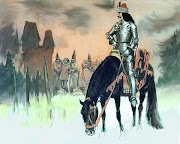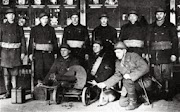Leon Trotsky and his Armored Train
Armored Trains, 1919-1921
Armored Trains were a fascinating bi-product of the technological innovation of railroads in the 19th and early 20th century. The American Civil War of 1861-1865 saw the first use of armored railway cars and they were first used in combat as early as 1862. In 1864 the Union Army developed an improved armored battery railway car to bombard the city of Vicksburg, Virginia. Armored trains were used in the Franco-Prussian War of 1870-1871 and the British deployed them with success in Egypt in the 1880’s and in South Africa during the Second Anglo-Boer War of 1899-1902.
White Russian Civil War armored train circa 1918-1919
The train as an offensive weapon truly came into its own during World War I with both the Austro-Hungarians and Russians using them to some degree of success. The Austro-Hungarian Panzerzugs were quite formidable serving with distinction on the Italian, Romanian, and Russian fronts from 1914-1916. During the Russian Civil War the armored train became one of the most potent and deadly weapons to be used by either side. Roads were few in number and often untraversable and so the railways became critical to the control of the Russian heartland during the conflict.
From 1916-1918 the best armored trains were christened ‘armored rail-cruisers’. These were massive heavily fortified and armored behemoths. Self propelled rail-cruisers were quick for their size; armored with thick metal and dotted with slots for rifles or machine guns. The armored rail-cruisers best weapons were heavy artillery pieces, mostly naval or field guns from the Great War as well as turreted gun emplacements which could fire in a 360 degree motion.
A White (pro-Tsarist) Panzerzug armored car with turret guns
Bolsheviks posing with battle standard in front of captured railway cruiser "Volf" c.1920
They became tools of war and destruction during the Civil War in Russia and in associated conflicts in other countries including Poland and the Ukraine in 1919-1920. Armored trains were feared wherever they went and Trotsky’s train, Revvoyensovet, was especially feared, even by his own Red Army comrades. Often times wherever an armored train went, death and hardship followed. A critical tactical component linked to the effectiveness of most of the armored trains in this period was the raiding party.
Trotsky on his train near the front-lines c.1919-1921
Raiding parties were used in concert with the natural defensive abilities and offensive capabilities of the armored train. Used first by the Imperial Russian army as shock troops who could be off loaded by train to attack or raid enemy positions during the Great War, the Red Army utilized raiding teams (desantniy otryads) on most of their large armored cars. A company of 165 troops plus 45 or so cavalry troopers with machine gun support from a mobile tachanka (horse-drawn machinegun cart) was the standard armored train raiding team.
They essentially had to fulfill three main objectives when in service, to protect the train when it was not moving down the tracks, raid enemy positions following an armored train attack, and to scout for enemy positions beyond the sight of the railway.
Red Army armored train with raiding party during the Russian Civil War
Trotsky’s Red 100
Trotsky's Bodyguards & Armored Train personnel, the Red Sotnia by A. Karachtchouk
The Red 100 staffed Trotskys armored trains’ and oversaw the heavily laid out defenses and offensive capabilities. They also protected him with their lives. They ensured that the ‘bandit’ anti-revolutionary army and their elite Tsarist cavalry could not kill or capture Trotsky in a lucky ambush or calculated assassination attempt. His train was arguably the best guarded in all of Russia or the world for that matter, during this time.
Trotsky standing next to a Red Sotnia c.1920
Their uniform and equipment, as depicted above by illustrator Andrei Karachtchouk, consisted most typically of a dyed red leather overcoat and red leather pants. Leather was prized by Red Army officers, elite troops, and armored train personnel who must have reveled (in the midst of widespread war, famine, and death) in wearing fine tailored items which offered some protection from the cold and blustery Russian weather but which were also very much in style.
His badge depicts Commander Trotsky’s armored train, Revvoyensovet, in silver and red. This soldier would have served from 1918-1922 during Trotsky’s time as chairman and head of the Red Army. This Red Sotnia soldier is armed with a Mosin-Nagant carbine of World War I vintage, two German style stick grenades, and a Nagant M1895 seven shot revolver, though the semi-automatic Mauser C-96 was often the more desired sidearm. He has two cartridge pouches on his belt and sports a red budenovka cap, the official head wear of the communist party and the Red Army until the late 1930’s.
Suggested Further Reading
Armored Trains Steven J. Zaloga (New Vanguard, Osprey Publishing, 2008)
The Russian Civil War (1) The Red Army M. Khvostov & A. Karachtchouk (Men-at-arms, Osprey Publishing)
Red Victory: A History of the Russian Civil War 1918-1921 W. Bruce Lincoln (Da Capo Press, 1989-1999)
Red Victory: A History of the Russian Civil War 1918-1921 W. Bruce Lincoln (Da Capo Press, 1989-1999)
Related Posts














